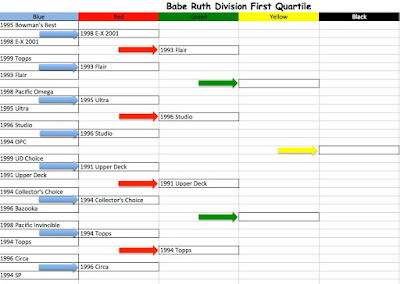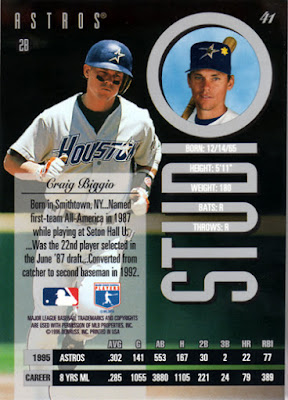A review of where all Phillies (at least the regulars) from the 2008 World Season have gone.
Pat Burrell - Left Field
2008 Bowman Gold #62
2011 Topps #546
Pat the Bat was in his 9th season with the Phillies in 2008. He had, for him, an average season. Not that that was a bad thing. He hit .250 with 33 home runs and 89 rbi. Pat did not have a good playoff season. He hit only 1 home run (in the NLDS) and only hit .071 (1 for 19) in the World Series. 2008 was his last season with the Phillies. He signed as a free agent by the Rays in 2009 and was released at the end of the season, and then signed with the Giants for 2010. He got a second chance at the World Series in 2010 but didn't perform any better than in 2008. He came back with the Giants in 2011 but spent most of the season on the DL with a foot injury. He signed a one-day contract with the Phillies so he could retire as a Phillie and was subsequently inducted to the Phillies Wall of Fame. He is currently a special assignment scout for the Giants.
Shane Victorino - Center Field
2015 Topps Allen & Ginter #336


The Phillies got Victorino from the Dodgers in the 2004 Rule 5 draft. In his first few years with the Phillies he spent time in all 3 outfield positions, but in 2008 and on, he primarily played center. He hit .293, had 14 home runs and 8 triples and won a gold glove in 2008. In the NLDS he hit a grand slam, the first Phillies slam in playoff history. In the NLCS he became a villain for the Dodgers fans after an altercation with Dodgers pitcher Hiroki Kuroda which resulted in the clearing of both benches. As an aside, you always hear that both benches cleared during an altercation. Is there ever a circumstance where only one bench clears and the other team stays in their dugout? Anyway, in 2012 the Phillies traded Shane back to the Dodgers, where I'm sure they loved him. He signed with the Red Sox for the 2013 season when he had one of his best seasons, hitting .294 with 15 home runs and leading the league with 18 HPB. Ouch. He has been in decline since then and was traded to the Angels earlier this season.
Jayson Werth - Left Field
2008 Topps Heritage #85
2015 Topps Heritage #295
After missing the entire 2006 season due to a wrist injury, the Phillies took a chance on him in 2007. In had 4 respectable years with the Phillies, from 2007-2010. On May 16, 2008 he had three home runs against the Blue Jays, a grand slam, a 3-run homer and a solo-shot, just missing the so-called "homer cycle". In the 2008 World Series, he was 8 for 18 with 3 doubles and 6 walks. After the 2010 season, Werth signed a 7-year, $126 million contract with the Nationals. His first 3 seasons with the Nats were productive, but he's struggling in 2015, hitting only .226.
Here are a few non-starters who made contributions to the 2008 Phillies
Geoff Jenkins - Right Field
2008 SP Authentic By The Letter Signatures
2008 Topps Allen & Ginter #317
After a successful 10-year career with the Brewers, Jenkins signed a 2-year, $13 million deal with the Phillies in Dec. 2007. He appeared in 115 games (all but two in right field) for the Phillies in 2008 hitting .246 with 9 home runs. He only had 4 at bats in the playoffs but his only hit, in the 6th game of the World Series, a double, helped the Phillies win the game and thus the series. The Phillies released Jenkins during spring training in 2009 and he decided to retire as a Brewer. He is currently on the coaching staff of the Peoria Explorers in the Freedom Pro Baseball League.
Greg Dobbs - 3rd Base
2008 Upper Deck Phillies World Series Champions #14
2013 Topps #356
Dobbs started 46 games for the Phillies in 2008 but made a real contribution as a pitch hitter. He led the majors with 22 pitch hits in 2008 for a .355 average. He also finished 2 in the majors with 16 rbi. He had 7 hits in 16 at bats in the playoffs. After disappointing seasons in 2009 and 2010, the Phillies released him and he spent a couple of years with the Marlins. He finished his career in 2014 with the Nationals. He is currently living in California and seeking a business degree.
Eric Bruntlett - Infield
2008 Topps Update #63
One last position player worth mentioning is Eric Bruntlett. Eric came over to the Phillis in 2008 from the Astros. He only started 48 games with the Phillies, ultimately getting into 115 games, playing the 3 infield positions in 2008. He had 6 at bats in the playoffs and only 2 hits, but one of those was a solo shot in the World Series. For a fairly short career, Bruntlett appeared in 3 World Series, 2008 and 2009 with the Phillies and 2005 with the Astros. After the 2010 season he decided to retire and be a stay-at-home Dad.










































































